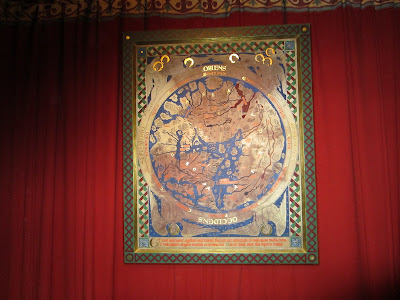"The Meeting Place," one of St. Pancras' large sculptures that I was able to photograph as we dashed through the station looking for our nephew AND the correct platform from which to depart.
Unfortunately southeast England was socked in with clouds that day and we had only a brief view of the Cliffs from the train. Dover itself is not a remarkable town but it has a castle and ruins that have been in existence since Roman times so up to the castle grounds we hiked. The castle area, given its strategic position as a gateway to London, was used as a military base continuously for about 700 years until 1958.
Dover Ferry as seen from the castle grounds. It was clear that we were close to France even if we could not see the shore since there were a number of dual language signs--some in train stations and some in the castle.
In earlier times, the site of the castle was an Iron Age Fort followed by two Roman lighthouses or "Pharos," one of which remains today.
"Pharos." The small Saxon church which dates from about 1000 AD can be seen next to it.
Church of St. Mary in Castro ("in Castle") The church is still used today by Army members and locals.
Welcome to the Great Tower! Mi Casa Su Casa?????
Today the Great Tower of the castle has been restored by a group known as English Heritage to what it would have looked like during the reign of Henry II in about 1180 (movie reference: "The Lion in Winter"). Although he was at least tangentially responsible for the death of Thomas a Becket, his one time friend and Archbishop of Canterbury, Henry had done penance for the act and now welcomed pilgrims on their way to Canterbury where Becket was being venerated as a martyr. However, the rich colors and opulent furnishings of his castle gave a clear message that Henry was a powerful man and not to be trifled with.
The Great Tower
The thrones, although wooden, would have been impressive because of the expensive dyes used in the paints.
Mappa Mundi, or Map of the World, the Medieval Ages version, in the room with the thrones.
The map was handmade and is based on a Mappa Mundi in the Corpus Christie College Library, Cambridge University. It was difficult for me to identify any known continents.
The Dining Hall
Some areas of the castle remain more or less as ruins.
The Barbican or outer fortification of the castle
Probably Dover is better known to us for its role in WW II. Tunnels that had been built in 1803 during the Napoleonic Wars as barracks were reused as headquarters for Operation Dynamo, the rescue of British and French forces from Dunkirk in 1940. We were unable to go on the tour of these tunnels because no tickets were available. We did see the tunnels that were used as a hospital during this time but no photography was allowed.
Statue of Sir Bertram Ramsey who oversaw Operation Dynamo
A day that wasn't very light to begin with was turning dark so we headed back to the train station and to London.
FYI: Bluebirds never flew over the White Cliffs of Dover; bluebirds are not indigenous to this area. But somehow, "There'll be gray gulls over the White Cliffs of Dover" doesn't have the same charm or sense of hope.











Nice!
ReplyDelete